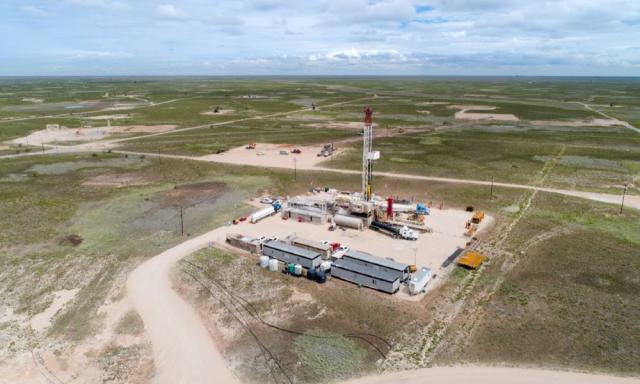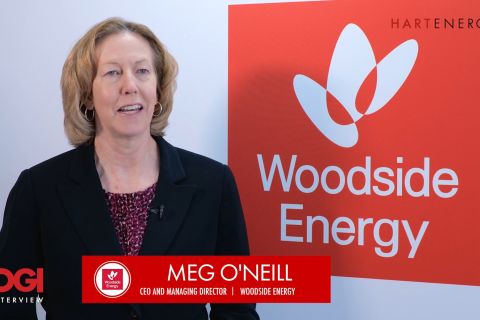
The Lower 48, including operations in the Permian Basin (shown above), represents the bulk of ConocoPhillips’ production. (Source: ConocoPhillips)
Oil prices have rebounded quicker than expected from a “double black swan” scenario that saw WTI futures sink into negative territory less than two months ago amid a global pandemic, but ConocoPhillips CEO Ryan Lance is concerned about what else could happen in the near term for the industry.
“There’s a lot of mixed signals going on,” Lance said. “I think it will be a bumpy few months” ahead.
Speaking with financial analyst Jordan Horoschak of CIBC Capital Markets during a June 10 Independent Petroleum Association of America webinar, the head of one of the world’s largest independent E&Ps said moves by U.S. oil and gas players to reduce production have helped balance the market along with that of OPEC+ participants, given demand was off at least 25 MMbbl/d.
Looking at storage builds, evidence that some operators are already coming back online given Brent trading at about $40/bbl and WTI at nearly $38/bbl, Lance said questions now are how quickly will curtailed production return to the market and will there be sufficient demand.
“We’re concerned a little bit about a double trough…as more production comes back on and if demand isn’t proceeding or coming back fast enough to absorb all that supply,” he said before turning to the refining side of the business. “Utilization rates and the running of big machines that chew up all of this oil are still down at around 71%-72% and that’s concerning. Are they going to come back fast enough to absorb some of this crude? And they’re not because the product inventory has been rising most on the distillate and gasoline.”
Oil prices have fallen by more than 35% since January. The global COVID-19 pandemic has zapped demand due to widespread travel restrictions. In response, oil and gas companies have drastically cut spending and production.
Demand, however, is slowly recovering as eased stay-at-home orders give hope for the return of normalcy. Plus, some governments are taking steps to help matters.
Government-mandated production cuts, such as the one considered by the Texas Railroad Commission, aimed to ease the pain, however, is not supported by ConocoPhillips. Lance noted struggles on the government’s part associated with how to bring production back and how the market works.
“If the U.S. industry comes back too quickly and the demand’s not there to absorb the extra supply then the prices are going to go back down; there’s going to be another price signal for suppliers to start thinking about,” he said. “So, the market is pretty efficient and we just think it’s going to send the right signals to producers on the supply side as demand fluctuates.”
There are steps governments can take to help improve conditions.
In Norway, politicians increased tax incentives for the industry, allowing companies to temporarily shield part of their income from taxes. The move encouraged Aker BP ASAS and Equinor ASA to proceed with several offshore projects, saving jobs and boosting the economy.
Lance called the step by Norway positive. But places like Alaska are “going in the wrong direction and talking about increasing taxes at a time when cash flows are very subdued.”
Although ConocoPhillips has the ability to shift capital, depending on fiscal stability and other risks in operating areas, he said “if the tax initiative passes in Alaska [in November], we will decrease capital.”
Such decisions determine where companies make long-term investments as they work to meet energy demand in the short-term amid continued volatility and uncertainty.
“Hopefully it [the oil price] stays north of $30 a barrel, because I think that’s going to allow for more production to come back,” Lance said. “If we see the demand keep rising, the market will stay relatively balanced.”
Weak prices led ConocoPhillips to voluntarily curtail oil production from its Lower 48, Canadian Surmont oil sands and Alaskan operations. About a third of its production—around 400,000 bbl/d—is shut in for June. It’s a mix of conventional and unconventional resources.
“We feel very comfortable that we’ll see that flush production coming back,” Lance said.
Forgoing cash flow, opting to produce later when prices are higher, makes sense, he said. It requires a strong balance sheet, though.
With $8 billion in cash on its balance sheet and about a $6 billion revolver, the company entered the downturn in a “relatively strong position” with plenty of liquidity, he said.
ConocoPhillips cut its planned 2020 capex by about 35% and planned operating costs by about 10%. Its share repurchase program was suspended along with original 2020 guidance.
“We’ve not made some of the personnel reduction actions that many of our peers have had to make because we tried to keep the productive capacity of the company intact,” Lance said.
If pricing recovery continues, the company hopes to slowly bring curtailed volumes back into the market. “We’ve reduced rigs. We’ve cut capital like most everybody has to manage through this downturn. So, we’re anxious to see some of that recovery in price and then get back to work,” he said.
Recommended Reading
US Raises Crude Production Growth Forecast for 2024
2024-03-12 - U.S. crude oil production will rise by 260,000 bbl/d to 13.19 MMbbl/d this year, the EIA said in its Short-Term Energy Outlook.
Exxon Versus Chevron: The Fight for Hess’ 30% Guyana Interest
2024-03-04 - Chevron's plan to buy Hess Corp. and assume a 30% foothold in Guyana has been complicated by Exxon Mobil and CNOOC's claims that they have the right of first refusal for the interest.
Petrobras to Step Up Exploration with $7.5B in Capex, CEO Says
2024-03-26 - Petrobras CEO Jean Paul Prates said the company is considering exploration opportunities from the Equatorial margin of South America to West Africa.
The OGInterview: How do Woodside's Growth Projects Fit into its Portfolio?
2024-04-01 - Woodside Energy CEO Meg O'Neill discusses the company's current growth projects across the globe and the impact they will have on the company's future with Hart Energy's Pietro Pitts.
Tech Trends: Halliburton’s Carbon Capturing Cement Solution
2024-02-20 - Halliburton’s new CorrosaLock cement solution provides chemical resistance to CO2 and minimizes the impact of cyclic loading on the cement barrier.





